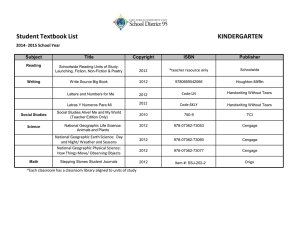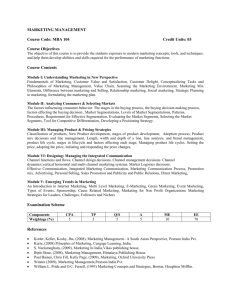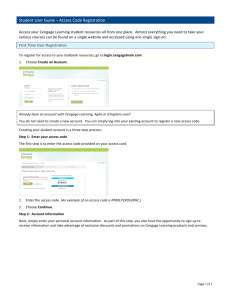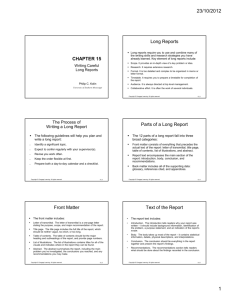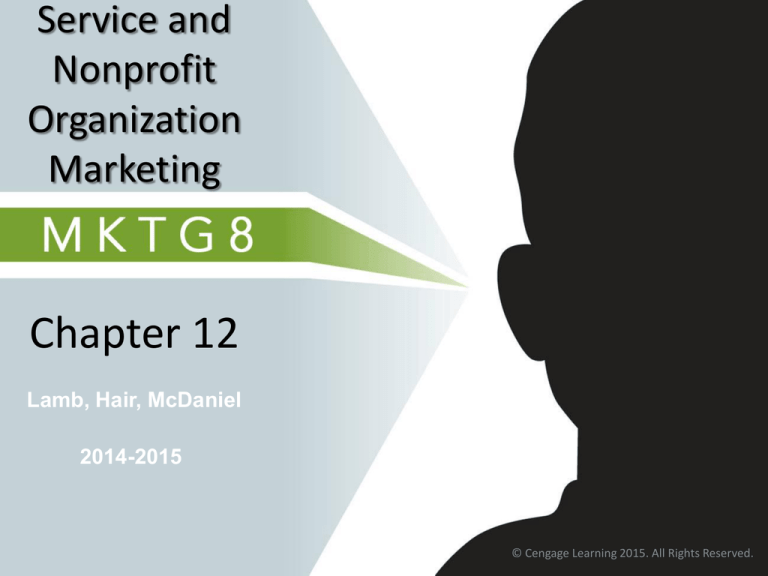
Service and
Nonprofit
Organization
Marketing
Chapter 12
Lamb, Hair, McDaniel
2014-2015
© Cengage Learning 2015. All Rights Reserved.
• Discuss the importance of services to the
economy
• Discuss the differences between services and
goods
• Describe the components of service quality and
the gap model of service quality
• Develop marketing mixes for services
• Discuss relationship marketing in services
• Explain internal marketing in services
• Describe nonprofit organizational marketing
• Discuss global issues in services marketing
© 2015 by Cengage Learning Inc. All Rights Reserved.
2
How Services
Differ from Goods
Intangible
Inseparable
No physical object makes it hard to
communicate benefits.
Production and consumption are
simultaneous, meaning the
consumer takes part in production.
Services depend on their
Heterogeneous employees for quality, which makes
consistency difficult to achieve.
Perishable
Services cannot be saved, and it is
challenging to synchronize supply
and demand.
2
© 2015 by Cengage Learning Inc. All Rights Reserved.
3
The Tangibility Continuum
Components of Service Quality
Reliability
The ability to perform the
service right the first time.
Responsiveness
The ability to provide
prompt service.
Assurance
The knowledge and courtesy
of employees.
Empathy
Caring, individualized
attention to customers.
Tangibles
The physical evidence
of the service.
3
© 2015 by Cengage Learning Inc. All Rights Reserved.
5
Exhibit 12.1
Gap Model of Service Quality
3
6
Service Strategies
(Similar to Product Strategies)
Service as a
Process
Core and
Supplementary
Customization/
Standardization
Service
Mix
4
© 2015 by Cengage Learning Inc. All Rights Reserved.
7
Service as a Process
People
Processing
Possession
Processing
Mental Stimulus
Processing
Information
Processing
4
© 2015 by Cengage Learning Inc. All Rights Reserved.
8
The Service Offering and Mix
Core
Service
The most basic benefit the
consumer is buying.
Supplementary
Service
A group of services that
support or enhance the
core service.
4
© 2015 by Cengage Learning Inc. All Rights Reserved.
9
Customization/Standardization
Mass
Customization
A strategy that uses
technology to deliver
customized services
on a mass basis.
4
© 2015 by Cengage Learning Inc. All Rights Reserved.
10
Place (Distribution) Strategy
Convenience
Number of outlets
Direct or indirect
distribution
Location
Scheduling
4
11
© 2015 by Cengage Learning Inc. All Rights Reserved.
Promotion Strategy
Stress tangible cues
Use personal information
sources
Create a strong
organizational image
Engage in postpurchase
communication
4
© 2015 by Cengage Learning Inc. All Rights Reserved.
12
Price Strategy
Pricing Challenges for Services
• Define the unit of service
consumption
• Determine if multiple elements
are “bundled” or priced
separately
4
© 2015 by Cengage Learning Inc. All Rights Reserved.
13
Pricing Objectives
Revenue-Oriented
Pricing
Maximize the surplus of
income over costs
OperationsOriented
Pricing
Match supply and demand
by varying price
PatronageOriented
Pricing
Maximize the number of
customers by varying price
4
© 2015 by Cengage Learning Inc. All Rights Reserved.
14
Relationship
Marketing in Services
3
Structural
Social
Financial
Creating valueadded services
not available
elsewhere
2
Social
Financial
Design services
to meet
customer needs
1
Financial
Pricing
incentives
5
© 2015 by Cengage Learning Inc. All Rights Reserved.
15
Internal Marketing
Treating employees as
customers and
developing systems and
benefits that satisfy their
needs.
6
© 2015 by Cengage Learning Inc. All Rights Reserved.
16
Nonprofit Organization
An organization that exists to achieve some
goal other than the usual business goals of
profit, market share, or return on investment.
• Governments
• Museums
• Theaters
• Schools
• Churches
7
© 2015 by Cengage Learning Inc. All Rights Reserved.
17
Nonprofit Organization
Marketing
Market intangible products
Shared
Characteristics
with
Service
Organizations
Production requires
customer’s presence
Services vary greatly
Services cannot be stored
7
© 2015 by Cengage Learning Inc. All Rights Reserved.
18
Nonprofit Organization
Marketing Activities
Identify desired customers
Specify objectives
Develop, manage, eliminate programs
and services
Decide on prices
Schedule events or programs
Communicate their availability
7
© 2015 by Cengage Learning Inc. All Rights Reserved.
19
Unique Aspects of Nonprofit
Organization Marketing Strategies
• Setting of marketing objectives
• Selection of target markets
• Development of marketing mixes
7
© 2015 by Cengage Learning Inc. All Rights Reserved.
20
Target Markets
Apathetic or
strongly opposed
targets
Pressure to adopt
undifferentiated
segmentation
Unique Issues
of Nonprofit
Organizations
Complementary
positioning
7
© 2015 by Cengage Learning Inc. All Rights Reserved.
21
Product Decisions
Distinctions between
Business and Nonprofit Organizations
• Benefit complexity
• Weak or indirect benefit strength
• Low involvement
7
© 2015 by Cengage Learning Inc. All Rights Reserved.
22
Promotion Decisions
Professional volunteers
Sales promotion activities
Public service advertising
7
© 2015 by Cengage Learning Inc. All Rights Reserved.
23
Pricing Decisions
Pricing objectives
Nonfinancial prices
Characteristics
Distinguishing
Pricing Decisions
of Nonprofit
Organizations
Indirect payment
Separation between
payers and users
Below-cost pricing
7
© 2015 by Cengage Learning Inc. All Rights Reserved.
24
Global Issues in
Services Marketing
• The U.S. is the world’s largest
exporter of services.
• The marketing mix must
reflect each country’s cultural,
technological, and political
environment.
8
© 2015 by Cengage Learning Inc. All Rights Reserved.
25
Ch 12 Discussion Questions
1. Define services and explain how they
differ from goods.
2. Define service and explain the service
marketing strategy of a company.
3. Define nonprofit marketing and explain
the nonprofit marketing strategy of a
company.
4. What is service quality? Explain.

